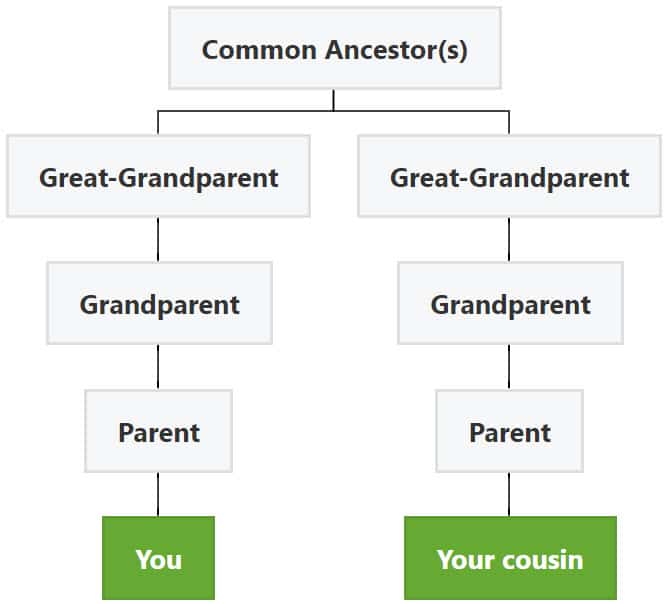Navigating the intricate web of family relationships can be a complex endeavor, particularly when terms like “third cousin” come into play. This article will delve into the meaning and definition of what constitutes a third cousin, tracing the genealogy that links family members in this way. You will learn how third cousins are related to each other, whether they are considered family, and how many such relatives the average person may have. Additionally, the article will explore the DNA shared between third cousins, the phenomena of third cousins with no shared DNA, and distinctions such as third cousins once-removed and half third cousins.
What is a third cousin?
Third cousins are relatives who share a common great-great-grandparent, which is four generations away from both individuals. In familial terms, first cousins have a shared grandparent (2 generations), second cousins are connected through a great-grandparent (3 generations), and third cousins share a great-great-grandparent. This systematic numbering helps to identify the specific relationship within the extended family tree.
Pro tip: Now that you understand third cousins, why not explore your family’s unique story? Try MyHeritage’s 14-day free trial to delve into billions of records and uncover your family’s tale. What stories await in your family tree?
A third cousin is the child of your parent’s second cousin. Your second cousin is the child of your parent’s first cousin, etc. Your children and your third cousin’s children would be fourth cousins. In most cases, your third cousin has a great-grandparent whose sibling is your great-grandparent. Thus, you and your third cousin share a set of great-great-grandparents.
Here is what that looks like:

Are third cousins considered family?
Depending on the family, you might know your third cousins personally. Close-knit families who stay within the same geographical areas, likely maintain relationships with distant family members generally having an older grandparent or great grandparent as a matriarch/patriarch that keeps the family held together like glue. When the older generations of these families end up dying, it is very common for distant relatives to lose touch. This has been the case in my own family. Though we know of our distant cousins, we have not seen each other in years though we do remain in “contact” through social media.
I know that my family get-togethers were an exception, most other families, who do not have these closer relationships likely do not know their third cousins or, they do know them as people, but they don’t know that they are cousins! Again, this scenario is common when families remain in the same geographic area but remember, we do live in a small world! If you were not close with any family outside of your siblings and parents, you probably wouldn’t be able to pick out your third cousins from a lineup.
How many third cousins does the average person have?
We can mathematically deduce that, on average, we have 190 third cousins (assuming each family has 2-3 children). We can have many many third cousins depending on the size of our common ancestor’s family.
What is a third cousin once-removed?
A third cousin once-removed means that they are not within your generation. So, to you, your third cousin’s child would be your third cousin once removed. Your third cousin, to your parents, would be their second cousin once removed. In order to differentiate your third cousins once removed on your DNA match list, you have to tree build to determine that their parent is your direct third cousin.
On your DNA match list, you won’t see anyone listed as “removed” cousins by default (on some sites you are able to manually select the relationship). You won’t see the words “removed” or “half” by default because of the genetic range of cMs with which we share with our cousins. So, how do we determine our “removed” cousins on our match list?
Do not let the terminology intimidate you. Distant cousins and the way they work into our family trees can hit our brains similar to a math problem and, I don’t know about you, but that generally makes my brain shut off. However, visual aid charts are something that can help ease our worries.
What is a half third cousin?
A half third cousin is when your great-grandparents are half-siblings and you would be sharing only one great-great-grandparent. Locating half cousins must also be done by finding how they fit into your tree. Oftentimes, people will have more half cousins than they realize because affairs cannot usually be traced genealogically but children born to affairs sure can be if their descendants have tested!
When we begin our research, we already have an idea about where to begin. We may also have preconceived notions of who our ancestors were. When it comes to grandparents, especially if you knew them personally, it is a hard pill to swallow when you locate an individual with whom you share DNA that likely came out of an affair.
I always remind people of this – You knew them only in one or two phases of their life. You cannot pass judgment on them in their youth but you cannot claim, especially when genetic evidence suggests it, that they were not “that type of person”. Sex is a very human thing, regardless of how often grandma or grandpa attended mass.
Climbing off my soapbox now, it is so incredibly beneficial to genetic research to locate these removed and half cousins, regardless if they are first, second or third. Through DNA testing, it is evident that they have some curiosities about the family’s history and it makes it a perfect opportunity to collaborate and to share copies of research and family stories or heirlooms that their direct line might not have even known about. As soon as these relationships are built, it is very very moving to have the realization that distant cousins can, unlike immediate family, sort of chosen despite the phrase, “you can pick your nose but you can’t pick your family”. When it comes to distant cousins, you truly can build relationships and become quite close and, for others, you don’t have to be friends if you don’t want to be!
Third cousins share anywhere from 30-230 cM (centiMorgans – unit of measurement of shared DNA) with each other according to the Shared Centimorgan Project. The average amount of DNA shared with a third cousin is about 74 cM but this can be on such a wide range for a plethora of different reasons.
It’s possible that third cousins do not share any DNA due to recombination. Depending on the testing company, anywhere between 90-98% of third cousins will share DNA with each other, according to the International Society of Genetic Genealogy.
Can third cousins marry?
Third cousins sometimes find themselves asking the question of whether they can marry. It is generally legal for third cousins to marry in most jurisdictions, and the genetic overlap between third cousins is minimal, reducing concerns related to genetic issues that might arise in offspring.
Cultural norms and individual family traditions might influence perceptions of third cousin marriages, but from a legal and genetic standpoint, such unions are typically permissible. A study published in Clinical Genetics titled “Consanguinity and its relevance to clinical genetics” sheds light on the broader context of consanguineous unions, highlighting that while Western society often regards marriage between close biological relatives with suspicion, many other populations have a strong preference for such unions, especially between first cousins.
It’s always advisable to consult local laws and cultural practices to ensure that a marriage between third cousins aligns with societal norms and legal requirements in a particular region.
Final thoughts
Locating how you relate to your DNA matches can only be beneficial for your family research. Third cousins are that perfect distance to prove and confirm your great-great grandparent’s lines. The best practice for keeping track of our Third Cousin (and more distant cousins) relationships, is building them in your family tree, or if they’re on your DNA match list (on certain site), you can edit their relationship to you or make a note about their relationship to you in order to prevent future confusion.
In my opinion, the more cousins the merrier. This is a notion that I am sure is not agreed on by everybody. To each their own but, regardless, we have many third cousins to “choose” from!
Read more about cousin relationships and kinship.

